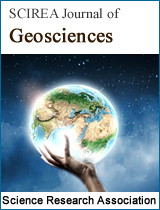Evaluation of Land Surface Temperature and Vegetation Relation Based on Landsat TM5 Data
DOI: 2573 Downloads 28363 Views
Author(s)
Abstract
Vegetation coverage has a significant role on the Land Surface Temperature (LST) distribution. Remote sensing technologies use the thermal infrared region of the electromagnetic spectrum in order to observe LST. In this paper spatial and temporal distribution of vegetation coverage, land surface temperature investigated, and the relationships among these factors are discussed. In the study LST values were derived from the thermal band of the Landsat 5 Thematic Mapper (TM). Vegetation cover of the test area was derived from the near-infrared and red bands of the Landsat 5 TM by using Normalized Difference Vegetation Index (NDVI). The spatial relationship between LST and NDVI was tested using Getis-Ord Gi* statistics.The results of the study reveal that vegetation cover was mostly influenced by the LST. The findings showed that in the study area, LST and the NDVI indicates the opposite spatial distribution, indicating that an increase in vegetation abundance would generally reduce surface temperatures.
Keywords
Land surface temperature; Vegetation indices; Thermal remote sensing
Cite this paper
Gulcan Sarp,
Evaluation of Land Surface Temperature and Vegetation Relation Based on Landsat TM5 Data
, SCIREA Journal of Geosciences.
Volume 1, Issue 1, October 2016 | PP. 1-11.
References
| [ 1 ] | Anbazhagan S. and Paramasivam C.R., “Statistical Correlation between Land Surface Temperature (LST) and Vegetation Index (NDVI) using Multi-Temporal Landsat TM Data”. International Journal of Advanced Earth Science and Engineering, 5 (1): 333-346, 2016. |
| [ 2 ] | Yue, W, Xu, J., Tan, W., and Xu, L, “The relationship between land surface temperature and NDVI with remote sensing: application to Shanghai Landsat 7 ETM+ data”. International Journal of Remote Sensing, 28, 3205-3226, 2007. |
| [ 3 ] | Yuan, F., and Bauer, M.E., “Comparison of impervious surface area and normalized difference vegetation index as indicators of surface urban heat island effects in Landsat imagery”. Remote Sensing of Environment, 106, 375-386. 2007. |
| [ 4 ] | Valor, E., and Caselles, V. “Mapping Land Surface Emissivity from NDVI: Application to European, African, and South American Areas”. Remote Sensing of Environment. 57; 167-184, 1996. |
| [ 5 ] | Goetz, S.J. “Multi-Sensor Analysis of NDVI, Surface Temperature and Biophysical Variables at a Mixed Grassland Site”. International Journal of Remote Sensing. 18 (1) 71-94, 1997. |
| [ 6 ] | Sandholt, I., Rasmussen, K., and Andersen, J. “A Simple Interpretation of the Surface Temperature and Vegetation Index Space for Assessment of Surface Moisture Status”. Remote Sensing of Environment. 79; 213-224, 2002. |
| [ 7 ] | Kim, H.M., Kim, B.K., and You, K.S. “A Statistic Correlation Analysis Algorithm between Land Surface Temperature and Vegetation Index” International Journal of Information Processing Systems, 1 (1) 102-106, 2005. |
| [ 8 ] | Shah, D.B., Pandya, M.R., Trivedi, H.J., and Jani, A.R. “Estimating Minimum and Maximum Air Temperature Using MODIS Data Over Indo-Gangetic Plain”. Journal of Earth System Science Indian Academy of Sciences, 122 (6) 1593-1605, 2013. |
| [ 9 ] | Orhan, O., Ekercin, S., and Filiz Dadaser-Celik. “Use of Landsat Land Surface Temperature and Vegetation Indices for Monitoring Drought in the Salt Lake Basin Area, Turkey”. The Scientific World Journal. 1-11, 2014. |
| [ 10 ] | Weng, Q., Lu, D., and Schubring, J. “Estimation of Land Surface Temperature–Vegetation Abundance Relationship for Urban Heat Island Studies”. Remote Sensing of Environmen, 89; 467-483, 2004. |
| [ 11 ] | Goetz, S.J. “Multi-Sensor Analysis of NDVI, Surface Temperature and Biophysical Variables at a Mixed Grassland Site”. International Journal of Remote Sensing. 18 (1) 71-94, 1997. |
| [ 12 ] | Wan, Z., Wang, P., and Li, X., “Using MODIS Land Surface Temperature and Normalized Difference Vegetation Index products for monitoring drought in the southern Great Plains, USA”. Int. J. Remote Sensing, 25(1): 61–72, 2004. |
| [ 13 ] | Chander, G., and Markham, B. “Revised Landsat-5 TM Radiometric Calibration Procedures and Post Calibration Dynamic Ranges”. IEEE Transactions on Geoscience and Remote Sensing. 41 (11) 2674-2677, 2003. |
| [ 14 ] | NASA, 2011: Landsat 7 Science Data Users Handbook. Landsat Project Science Office at NASA Goddard Space Flight Centre, Greenbelt, 186 (http://landsathandbook.gsfc.nasa.gov) |
| [ 15 ] | Sarp, G., “Determination of Vegetation Change Using Thematic Mapper Imagery in Afşin-Elbistan Lignite Basin; SE Turkey”. Procedia Technology, 1, 407 – 411, 2012. |
| [ 16 ] | Tobler, W. R., “A computer movie simulating urban growth in the Detroit region”. Economic Geography, 46: 234–40. 1970. |
| [ 17 ] | Mitra, S., “Spatial autocorrelation and Bayesian spatial statistical method for analyzing fatal and injury crash prone intersections”. In Transportation Research Record: Journal of the Transportation Research Board, No. 2136, TRB, Washington, D.C., pp. 92-100, 2009. |
| [ 18 ] | Getis, A., Ord, J.K.,. “The analysis of Spatial Association by use of Distance Statistics”. Geographic Analysis, 24 (3), 189-206, 1992. |
| [ 19 ] | Ord, J. K., Getis, A., “Local Spatial Autocorrelation Statistics: Distributional Issues and An Application”, Geographical Analysis 27 (4): 286 – 306, 1995 |
| [ 20 ] | Chander, G. and Markham, B. “Revised Landsat-5 TM Radiometric Calibration Procedures and Postcalibration Dynamic Ranges”. Ieee Transactıons On Geoscıence And Remote Sensıng, 41, (11), 2003. |

